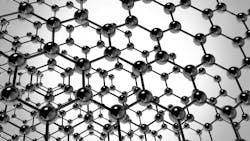Rice Process Eliminates PFAS, Generates Graphene
A new method for destroying per- and polyfluoroalkyl substances (PFAS) not only eliminates them from water systems but also generates high-value graphene.
Researchers at Rice University developed the zero net cost method, which relies on flash Joule heating (FJH) technology.
The researchers combined granular activated carbon (GAC) saturated with PFAS and mineralizing agents such as sodium or calcium salts and applied a voltage that took the mixture’s temperature to over 3000°C in under a second.
Under such extreme conditions, PFAS are converted into inert, non-toxic fluoride salts with >90% fluorine and >99% PFOA and PFOS – two of the most common PFAS pollutants - removal. Spent carbon is upcycled into flash graphene, offsetting treatment costs by $60–100/kg.
The sample is heated in a quartz tube with an inner diameter of 8 mm and a length of 9cm. The sample is fitted between two snug graphite electrodes, each 3mm long. 0.5g of copper wool is placed on each side of the graphite electrodes to enhance the electrical contact between the sample and external brass electrodes. The quartz tube, containing the sample, electrodes, and copper wool, is placed between two brass electrodes, each with two grooves fitted with O rings. This allows the sample and reaction area to be well sealed to minimize the volatilization of any reaction species as off-gas. This setup maximizes the formation of inorganic fluoride species by maximizing feedstock retention throughout the flash (Figure 1).
The method, described in a recent Nature Water is solvent- and catalyst-free, and a techno-economic assessment highlights its scalability and environmental benefits.
According to study lead James Tour, the T.T. and W.F. Chao Professor of Chemistry and professor of materials science and nanoengineering at Rice, it works with all PFAS compounds, including Teflon.
His group already has published over 30 papers in which the department’s FJH-based methods are used for everything from recovery of metals from ores and waste to making of carbon nanotubes, graphite and over 20 inorganics.
The biggest challenge to scaling up the process is access to enough electricity, Tour notes. However, he points out that Universal Matter, Burlington, ON., is currently using FJH technology to produce more than 1 t/d of graphene.
Mineral exploration and metal recovery technology specialist MTM Critical Metals Limited, West Perth, Australia, has acquired exclusive licensing rights to FJH technology.
About the Author
Seán Ottewell
Editor-at-Large
Seán Crevan Ottewell is Chemical Processing's Editor-at-Large. Seán earned his bachelor's of science degree in biochemistry at the University of Warwick and his master's in radiation biochemistry at the University of London. He served as Science Officer with the UK Department of Environment’s Chernobyl Monitoring Unit’s Food Science Radiation Unit, London. His editorial background includes assistant editor, news editor and then editor of The Chemical Engineer, the Institution of Chemical Engineers’ twice monthly technical journal. Prior to joining Chemical Processing in 2012 he was editor of European Chemical Engineer, European Process Engineer, International Power Engineer, and European Laboratory Scientist, with Setform Limited, London.
He is based in East Mayo, Republic of Ireland, where he and his wife Suzi (a maths, biology and chemistry teacher) host guests from all over the world at their holiday cottage in East Mayo.


